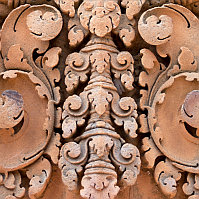
The German Angkorian Imagery Project
• G • A • I • P •
Most visitors asked which was the most beautiful temple they saw in Cambodia, will answer: Angkor Wat was great, but we love Banteay Srei most. And Cambodians will tell you: As long as you have not seen Banteay Srei you have not seen Cambodia. Indeed, Banteay Srei is a top candidate for a competition: Which is the nicest temple in the world?
What is special about Banteay Srei, is its abundance in carvings and the perfect harmony of architectural and sculptural art. Actually, at Banteay Srei building and ornamentation is nearly undiscernable, as in the case of the best examples of fine arts in India. But in contrast to Indian masterpieces Banteay Srei is not over-ornate. It's design is discreet, more delightful than impressive. Its dimensions are modest. Most visitors are surprised, how small Banteay Srei is. For example, the doorway of the central shrine is only 108 cm high, Apsaras and guardians only 70 cm tall. But nobody will be disappointed because of the miniature size of Banteay Srei. The fairyland temple fills everyone with enthusiasm.
Banteay Srei, sometimes spelt Banteay Srey or Bantay Srei, means "citadel of the women". This modern name may refer to its delicate beauty. Its original name was Tribhuvanamaheshwara, which seems to be a term not easy to memorize, but it is simple: In Sanskrit "Tri" means "Three", "bhuvana" is "world", "maha" means "great", "ishvara" is "lord". Maheshwara is one of the names or appearances of Shiva. Tribhuvana-Maheshwara was the name of the central icon, too, a Shiva-Lingam. A small settlement called Ishvarapura, "the Lord's city", surrounded the temple.
Though a Lingam usually is identified with the power of a Khmer king and indicates a state temple, the intricate temple of Banteay Srei, remarkably, was not even founded by a king. Rather, a counsellor of Rajendravarman II and teacher of Jayavarman V, named Yajnavaraha, erected this splendid work of art. Banteay Srei was not a royal, but a so-called private temple. In its time, in the second half of the tenth century, there were many more temples built by aristocrats or court officials. Prasat Kravan is an earlier example. But none of these private temples shows the ambition and magnificence of Banteay Srei. The temple was consecrated on April 22nd, 967.
As usual, Banteay Srei is facing east and arranged in three nearly concentric enclosures. An outer Gopuram marks the eastern boundary of the city, but a stone wall is missing here.
A 67 m long avenue leads to the outer temple enclosure, measuring 110 m by 95 m. Inside this third enclosure there is a wide moat. The principal structure, consisting of the first and second enclosures, almost appears like a temple on an island. Its exterior second enclosure is astonishingly close to the inner or first one.
The three sanctuary towers are arranged in a north-south line, the southern and central Prasats were dedicated to Shiva, the northern tower to Vishnu. The central one is preceded by a Mandapa hall, connected with it by a corridor called Antarala. Two corner buildings in the inner enclosure are libraries. These buildings and the Gopurams of this first enclosure are the jewels of Khmer art mentioned above, decorated with the finest and most detailed examples of bas-reliefs you can find in Cambodia or anywhere else.
The famous pediment and lintel carvings are many. For example, the east-facing pediment at the southern library shows the multi-headed demon-king of Lanka, Ravana, shaking Mount Kailasa, on which Shiva and his consort Uma are seated. On the west facade of the same library building is Kama, the god of love, firing an arrow at Shiva. Other panels show Vishnuite scenes. For example the west pediment of the northern library depicts Krishna killing his evil uncle Kamsa.
There is a depiction of the dancing Shiva called Nataraja at the easrern front of the eastern Gopuram of the first enclosure, which is in front of the main building. His dance is the rythm of the world. Shiva's dance creates the periods of time. Accelerating the very same creation dance the Lord will also destroy the world. At the feet of the multi-armed Shiva you can see a drummer and an his disciples.
The sandstone used for such elaborate carvings had to be of extraordinary quality. Indeed, the red sandstone is a hallmark of the style of Banteay Srei, never used in other Angkor styles. Its hardness is the reason, too, why even after one millenium the Banteay Srei carvings are the best preserved examples of Angkorian relief art, almost unchanged as scarcely anything is weathered.
The lovely guardian figures at the stairways to the terrace of the Prasats and Mandapa are copies. Some originals were damaged or stolen or they are in museums now.
Banteay Srei was discovered by French in 1914. In 1923 Andre Malraux, the future French Minister of Culture in Charles de Gaulle's cabinet, was arrested for plundering it. The pieces stolen by him were returned.
Ernst Ando Sundermann
• G • A • I • P •
Copyright © 2019 khmer-heritage.de